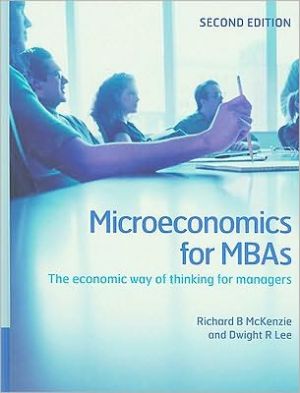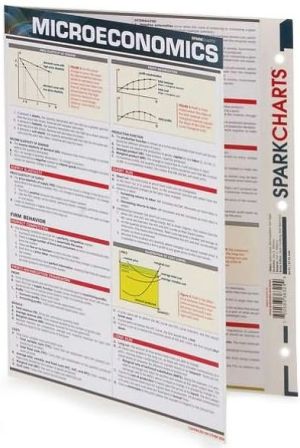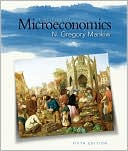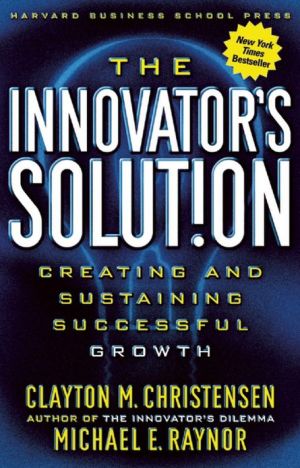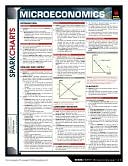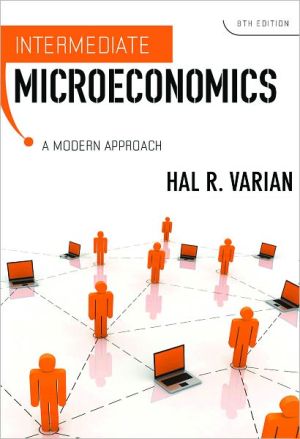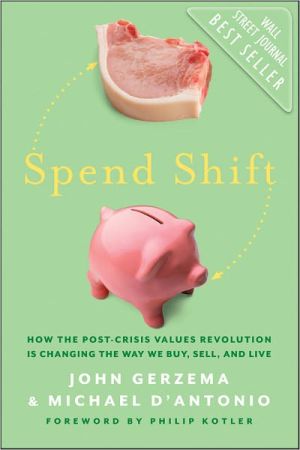Microeconomics for MBAs: The Economic Way of Thinking for Managers
This is the first textbook in microeconomics written exclusively for MBA students. McKenzie/Lee minimizes attention to mathematics and maximizes attention to intuitive economic thinking. The text is structured clearly and accessibly: Part I of each chapter outlines the basic theory and Part II applies this basic theory to management issues. 'Perspective' sections in each chapter provide a new line of argument or different take on a business or policy issue, and carefully chosen topics and...
Search in google:
The first textbook in microeconomics written exclusively for MBA students.
\ Cambridge University Press\ 0521859816 - Microeconomics for MBAs - The Economic Way of Thinking for Managers - by Richard B. McKenzie and Dwight R. Lee\ Excerpt\ \ \ \ \ CHAPTER 1\ Microeconomics: a way of thinking about business\ \ \ \ In economics in particular, education seems to be largely a matter of unlearning and "disteaching" rather than constructive action. A once- famous American humorist observed that "it's not ignorance that does so much damage; it's knowin' so darn much that ain't so" . . . It seems that the hardest things to learn and to teach are things that everyone already knows. Frank H. Knight\ The late Frank Knight was a wise professor at the University of Chicago who realized that students - even those who are in advanced business programs - beginning a study of economics, no matter the level, face a difficult task. They must learn many things in a rigorous manner that, on reflection and with experience, amount to common sense. To do that, however, they must set aside - or "unlearn" - many preconceived notions of the economy and of the course itself. The problem of "unlearning" can be especially acute for MBA students who are returning to a university after years of experience in industry. People in business rightfully focus their attention on the immediate demands of their jobs and evaluate their firms' successes and failures with reference to production schedules and accounting statements, a perspective that stands in stark contrast to the perspective developed in an economics class.\ You are now one of the many students at whom Knight directed his comments. As all good teachers must do, we intend to challenge you in this course to rethink your views on the economy and the way firms operate. We shall ask you to develop new methods of analysis, maintaining all the while that there is, indeed, an "economic way of thinking" that deserves to be mastered. We shall also ask you to reconsider, in light of the new methods of thinking, old policy issues - both inside and outside the firm - about which you may have fixed views. These tasks will not always be easy for you, but we are convinced that the rewards from the study ahead are substantial. The greatest reward may be that this course of study will help you to better understand the way the business world works and how businesses may be made more efficient and profitable.\ Each chapter is divided into two major parts. The first part (Part I) will always develop microeconomic concepts and theories and apply the concepts and theories to social and economic policies. Part II will always apply the theory directly to issues that mid-level and executive-level managers confront all the time. Sandwiched in between those two major sections will be a "Perspective" that covers some policy or management topic new to economics or that provides a novel take on a topic that has been mistakenly accepted among economists and lay people to economics as settled.\ We understand that time is a scarce commodity for most MBA students, especially those who have to balance their studies with the demands of a full-time job and a family. Accordingly, we conclude each chapter with a section which we call "The bottom line," which itemizes and crystallizes the most important points developed in the chapter. We have deliberately kept these lists of "key takeaways" short.\ Throughout the volume, we have one goal: to change the way you think about the world in large and small ways. When you complete this book, your view of how markets work (and fail to work) should be greatly clarified, with an improved ability to predict market outcomes. You will see more clearly the manager's role as one of coping with, and responding to, the competitive market forces that are ever-present outside the doors of every business, pressing both owners and executives to pay as much attention to the way business organizations and executive and line workers' incentives are structured as to how products are created and developed.\ You will naturally be able to make observations that might, without going through this course of study, escape your attention. For example, most people now understand the entire world, not just the United States, faces a growing weight problem, which is giving rise to a growth in obesity-related health problems which, in turn, are driving up firms' health insurance costs and depriving workers of increases in money wages (Brody 2005; Girion 2005).\ Having completed this book, you will naturally think about how people's weight problems are founded, at least partially, on the growing openness and competitiveness of the world's food markets, which is driving down the cost of food and driving up people's real incomes, with both effects leading to more food consumption - and people's expanded girths and backsides. You will also naturally wonder how managers will change their pay offers for prospective overweight workers, since the healthcare costs of such workers can be expected to feed into company health insurance costs. Indeed, might not competitive market forces be expected to put downward pressures on the money wages of overweight workers and upward pressures on prospective workers who maintain a healthy weight (and lifestyle)?\ On completing this book, you will no longer be able to assess the terrorists' attack on the World Trade Center towers on September 11, 2001 as having only political or military consequences. After all, the 9/11 attack immediately hiked many people's perceived risk of flying, as well as caused a substantial lengthening of security lines at airports - with both factors - risk and wait time - increasing the total cost of plane trips. You will naturally understand why economic academic researchers have looked for, and found, that the greater cost of flying from the terrorists' actions should be expected to lead to - and apparently has led to - more people driving to many destinations, the consequence of which should have been more automobile accidents, injuries, and deaths (Blalock, Kadiyali, and Simon 2005a, 2005b).1\ Hence, you will understand with greater facility after completing this book how airport security is truly a management problem with life-and-death consequences: Tighter airport security can have two opposing effects. First, it can increase the cost of flying (by increasing the length of the security lines), which can lead to less flying and more driving - and more highway accidents, injuries, and deaths. Second, the greater security can reduce the risk of flying and, thus, can increase the demand for flying (and reduce the demand for driving). Which effect is stronger? To date, the evidence suggests that, on balance, raising the alert status at airports from, say, yellow to orange can lead to more driving and more road deaths (Blalock, Kadiyali, and Simon 2005a, 2005b). Managers of the nation's homeland security system must weigh their actions very carefully and, before they raise the alert status, feel reasonably confident that the higher alert status will avert more deaths in the air than will arise on the nation's roads. Hence, we should expect that airport homeland security managers will often not elevate the alert status when the increase in the perceived risk of terrorist attacks is small.\ In casual conversations, business people talk as though they know many things that few listeners think to challenge:\ "Houses with views sell quicker than houses without views."\ "Buying a house is a better deal than renting a comparable size apartment because houses carry tax advantages (interest on home mortgages is deductible from taxable incomes)."On completing this textbook and hearing any such comment, you will be inclined to ask reflectively and in earnest, "How can that be?"\ The kind of economic thinking that will be central to this book, and evident in the foregoing discussions of obesity and airport security and any assessment of the above statements, springs from an innocuous observation: People have a basic drive to improve their lot in life because they don't have everything they want and need. Much of this introductory chapter and the book (and the course), in both theory and in application, is directed at driving home this easily overlooked lesson. Oddly enough, many lessons covered in this book are crystallized in a story of what happened in a German prisoner-of-war (POW) camp during the Second World War, as related by a prisoner who happened to be a trained economist.\ A market is the process by which buyers and sellers determine what they are willing to buy and sell and on what terms. It is the process by which buyers and sellers decide the prices and quantities of goods that are to be bought and sold.\ \ PART I THEORY AND PUBLIC POLICY APPLICATIONS\ The emergence of a market\ Economic systems spring from people's drive to improve their welfare. R. A. Radford, an American soldier who was captured and imprisoned during the Second World War, left a vivid account of the primitive market for goods and services that grew up in the most unlikely of places, in his POW camp (Radford 1945). Because the inmates had few opportunities to produce the things they wanted, they turned to a system of exchange based on the cigarettes, toiletries, chocolate, and other rations distributed to them periodically by the Red Cross.\ The Red Cross distributed the supplies equally among the prisoners, but "very soon after capture . . . [the prisoners] realized that it was rather undesirable and unnecessary, in view of the limited size and the quality of supplies, to give away or to accept gifts of cigarettes or food. Goodwill developed into trading as a more equitable means of maximizing individual satisfaction" (Radford 1945, 190).\ As the weeks went by, trade expanded, and the prices of goods stabilized. A soldier who hoped to receive a high price for his soap found he had to compete with others who also wanted to trade soap. Soon shops emerged, and middlemen began to take advantage of discrepancies in the prices offered in different prisoners' bungalows.\ For example, a priest, one of the few prisoners allowed to move freely among the prison bungalows, found that he could exchange a pack of cigarettes for a pound of cheese in one bungalow, trade the cheese for a pack and a half of cigarettes in a second bungalow, and return home with more cigarettes than he had started with. Although he was acting in his own self-interest (not so much out of religious convictions), he had provided the people in the second bungalow with something they wanted - more cheese than they would otherwise have had. In fact, prices for cheese and cigarettes differed partly because prisoners in different bungalows had different desires and partly because they could not all interact freely. To exploit the discrepancy in prices, the priest moved the camp's store of cheese from the first bungalow, where it was worth less, to the second bungalow, where it was worth more. Everyone involved in the trade benefited from the priest's enterprise.\ A few entrepreneurs in the camp hoarded cigarettes and used them to buy up the troops' rations shortly after issue, and then sold the rations just before the next issue, at higher prices. Although these entrepreneurs were pursuing their own private interest, like the priest, they were providing a service to the other prisoners. They bought the rations when people wanted to get rid of them and sold them when people were running short. The difference between the low price at which they bought and the high price at which they sold gave them the incentive they needed to make the trades, hold on to the rations, and assume the risk that the price might not rise.\ An entrepreneur is an enterprising person who discovers potentially profitable opportunities and organizes, directs, and manages productive ventures.\ Soon the troops began to use cigarettes as money, quoting prices in packs or fractions of packs. (Only the less desirable brands of cigarette were used this way; the better brands were smoked.) Because cigarettes were generally acceptable, the soldier who wanted soap no longer had to search out those who might want his jam; he could buy the soap with cigarettes. Even nonsmokers began to accept cigarettes in trade.\ This makeshift monetary system adjusted itself to allow for changes in the money supply. On the day the Red Cross distributed new supplies of cigarettes, prices rose, reflecting the influx of new money. After nights spent listening to nearby bombing, when the nervous prisoners had smoked up their holdings of cigarettes, prices fell. Radford saw a form of social order emerging in these spontaneous, voluntary, and completely undirected efforts. Even in this unlikely environment, the human tendency toward mutually advantageous interaction had asserted itself.\ Today, markets for numerous new and used products spring up spontaneously in much the same way. At the end of each semester, college students can be found trading books among themselves, or standing in line at the bookstore to resell the books they bought at the beginning of the semester. Garage sales are now common in practically all communities (with eBay effectively being the largest global "garage sale"). Indeed, like the priest in the POW camp, many people go to garage sales to buy what they believe they can resell - at a higher price, of course. "Dollar stores" have sprung up all over the country for one purpose, to buy the surplus merchandise from manufacturers and to unload it at greatly reduced prices to willing customers. There are even firms that make a market in getting refunds for other firms on late overnight deliveries. Many firms don't think it is worth their time to seek refunds for late deliveries, mainly because they individually don't have many late deliveries (because the overnight delivery firms have an economic incentive to hold the late deliveries in check). However, there are obviously economies to be had from other firms collecting the delivery notices from several firms and sorting the late ones out, with the refunds shared by all concerned.\ Today, we stand witness to what is an explosion of a totally new economy on the Internet that many of the students reading this book will, like the priest in the POW camp, help to develop. More than two hundred years ago, Adam Smith, a moral philosopher considered to be the first economist, outlined a society that resembled these POW camp markets in his classic Wealth of Nations (1776) (Smith 1937). Smith asked why firms and markets arise, and how they contribute to social and economic improvement. When Smith wrote his bestseller, many of his points were considered novel and controversial. Now, many of his points are a part of conventional economic wisdom - and have been incorporated, with refinements and updating, in this textbook.\ \ The economic problem\ Our world is not nearly as restrictive as Radford's POW camp, but it is no Garden of Eden, either. Most of us are constantly occupied in securing the food, clothing, and shelter we need to exist, to say nothing of those things we would only like to have - a high-definition television, a trip to Taihiti, and a shopping spree. Indeed, if we think seriously about the world around us, we can make two general observations.\ Resources are things used in the production of goods and services. There are only so many acres of land, gallons of water, trees, rivers, wind currents, oil and mineral deposits, trained workers, and machines that can be used in any one period to produce the things we need and want.\ First, the world is more or less fixed in size and limited in its resources. We can plant more trees, find more oil, and increase our stock of human talent, but there are limits on what we can accomplish with the resources at our disposal.\ Economists have traditionally grouped resources into four broad categories: land, labor, capital (also called investment goods), and technology.2 To this list, some economists would add a fifth category, entrepreneurial talent. The entrepreneur is critical to the success of any economy, especially if it relies heavily on markets. Because entrepreneurs discover more effective and profitable ways of organizing resources to produce the goods and services people want, they are often considered a resource in themselves.\ Second, in contrast to the world's physical limitations, human wants abound. You yourself would probably like to have books, notebooks, pens and a calculator, perhaps even a computer with a several gigahertz microprocessor and a 200 gigabyte hard-disk drive. A stereo system, a car, more clothes, a plane ticket home, a seat at a big concert or ballgame - you could probably go on for a long time, especially when you realize how many basics, like three good meals a day, you normally take for granted.\ In fact, most people want far more than they can ever have. One of the unavoidable conditions of life is the fundamental condition of scarcity. Put simply, there isn't enough of everything to go around. Consequently, society must face four unavoidable questions:\ Scarcity is the fact that we cannot all have everything we want all the time.\ (1) What will be produced? More guns or more butter? More schools or more prisons? More cars or more art, more textbooks or more "Saturday night specials"?\ (2) How will those things be produced, considering the resources at our disposal? Shall we use a great deal of labor and little mechanical power, or vice versa? And how can a firm "optimize" the use of various resources, given their different prices?\ (3) Who will be paid what and who will receive the goods and services produced? Shall we distribute them equally? If not, then on what other basis shall we distribute them?\ (4) Perhaps most important, who will determine how the above questions shall be answered? Shall we allow for individual freedom of choice, or shall we make all these decisions collectively?\ These questions have no easy answers. Most of us spend our lives attempting to come to grips with them on an individual level. What should I do with my time today - study or work on company projects (beyond what my job requires)? How should I study - in the library or at home with my MP3 on? Who is going to benefit from my efforts - me or my spouse, who wants me to succeed? Am I going to live by principle or by habit? Take each day as it comes or plan ahead? In a broader sense, these questions are fundamental not just to the individual but to all the social sciences, economics in particular. Indeed, most economists see the fact of scarcity as the foundation of economics. More to the point, economics is a way of thinking about how people, individually and collectively in various organizations (including firms), cope with scarcity.\ Economics is the study of how people cope with scarcity - with the pressing problem of how to allocate their limited resources among their competing wants in order to satisfy as many of those wants as possible.\ The problem of allocating resources among competing wants is not as simple as it may first appear. You may think that economics is an examination of how one person, or a small group of people, makes fundamental social choices on resource use. That is not the case. The problem is that we have information about our wants and the resources at our disposal that may be known to no one else. This is a point the late Leonard Read made (Read 1983) in a short article concerning what it takes to produce a product as simple as a pencil, and it also is a point that F. A. Hayek stressed in many of his writings that, ultimately, gained him a Nobel Prize in economics (Hayek 1945). (We have included Read's short article in an appendix to this chapter, p. 42.)\ For example, as Read and Hayek might note about your own personal context as you read this page, you may know you want a calculator because your statistics class requires you to have one, but even your friends (much less the people at Hewlett-Packard or Samsung) do not yet know your purchase plans. You may also be the only person who knows how much labor you have, which is determined by exactly how long and intensely you are willing to work at various tasks in your MBA program and at work. At the same time, you may know little about the wants and resources that other people around the country and world may have (or even your cohorts in your MBA study groups). Before resources can be effectively allocated, the information we hold about our individual wants and resources must somehow be communicated to others. This means that economics must be concerned with systems of communications - e.g. the priest in the POW camp who used both words and prices to convey information about how the troops in the various bungalows assessed the value he had to offer. Indeed, the field is extensively concerned with how information about wants and resources is transmitted or shared through, for example, prices in the market process and votes in the political process. Indeed, the "information problem" is often acute within firms, given that the CEO often knows little about how to do the jobs at the bottom of the corporate "pyramid." The information problem is one important reason that firms must rely extensively on incentives to get their workers (and managers) to pursue firm goals.\ Markets like the one in the POW camp and even the firms that operate within markets emerge in direct response to scarcity. Because people want more than is immediately available, they produce some good and services for trade. By exchanging things they like less for things they like more, they reallocate their resources and enhance their welfare as individuals. As we will see, people organize firms, which often substitute command-and-control structures for the competitive negotiations and exchanges of markets, because the firms are more cost-effective than markets. Firms can be expected to expand only as long as things can be done more cost-effectively through firms than through competitive market trades. This means that many firms fail not only because of things they do wrong (allow costs to get out of control), but because market trades between firms become less costly (through improved telecommunications), thus causing firms to outsource their needed services and shed their employees.\ \ \ \ The scope of economics\ MBA students often associate economics with a rather narrow portion of the human experience: the pursuit of wealth; money and taxes; commercial and industrial life. Critics often suggest that economists are oblivious to the aesthetic and ethical dimensions of human experience. Such criticism is partly justified. Increasingly, however, economists are expanding their horizons and applying the laws of economics to the full spectrum of human activities.\ The struggle to improve one's lot is not limited to the attainment of material goals. Although most economic principles have to do with the pursuit of material gain, they can be relevant to aesthetic and humanistic goals as well. The appreciation of a poem or play can be the subject of economic inquiry. Poems and plays, and the time in which to appreciate them, are also scarce.\ Jacob Viner, a distinguished economist active in the first half of the twentieth century, once defined economics as "what economists do." Today, economists study an increasingly diverse array of topics. As always, they are involved in describing market processes, methods of trade, and commercial and industrial patterns. They also pay considerable attention to poverty and wealth; to racial, sexual, and religious discrimination; to politics and bureaucracy; to crime and criminal law; and to revolution. There is even an economics of group interaction, in which economic principles are applied to marital and family problems. And there is an economics of firm organization and the structure of incentives inside firms.\ What is the unifying factor in these diverse inquiries? What ties them all together and distinguishes the economist's work from that of other social scientists? Economists take a distinctive approach to the study of human behavior, and they employ a mode of analysis based on certain presuppositions. For example, much economic analysis starts with the general proposition that people prefer more to fewer of those things they value and that they seek to maximize their welfare by making reasonable, consistent choices in the things they buy and sell. These propositions enable economists to derive the "law of demand" (people will buy more of any good at a lower price than at a higher price, and vice versa) and many other principles of human behavior.\ One purpose of this book is to describe the economic approach in considerable detail - to develop in precise terms the commonly accepted principles of economic analysis and to demonstrate how they can be used to understand a variety of problems, including pollution, unemployment, crime, and ticket scalping - as well as firms' organizational and financial structures. In every case, economic analysis is useful only if it is based on a sound theory that can be evaluated in terms of real-world experience. This mode of analysis - sometimes dubbed the "economic way of thinking" - will appear time and again as you move through your MBA programs, most prominently in your finance, accounting, marketing, and strategy courses.\ \ \ \ Developing and using economic theories\ The real world of economics is staggeringly complex. Each day millions of people engage in innumerable transactions, only some of them involving money (about 30 percent), and many of them undertaken for conflicting reasons (McMillan 2002, 168-9). To make sense of all these activities, economists turn to theory.\ A theory is a model of how the world is put together; it is an attempt to uncover some order in the seemingly random events of daily life. Theory is how we make sense of the world.\ \ \ \ \ © Cambridge University Press
PrefaceHow to use this bookList of online perspectivesList of Further readings onlineList of online video modulesBook I The market economy, overview and application1 Microeconomics: a way of thinking about business 3Part A Theory and public policy applications 7The emergence of a market 7The economic problem 10The scope of economics 13Developing and using economic theories 14Microeconomics and macroeconomics 14Private property rights, game theory, and the Prisoner's Dilemma 16Private property rights and the games economists play 17Communal property rights and the "tragedy of the commons" 25Voluntary organizations and firms as solutions for "tragedies of the commons" 30Part B Organizational economics and management 31Managing through incentives 31Why incentives are important 35Practical lessons for MBAs: see management as a problem in solving Prisoners Dilemmas 38Further reading online 39The bottom line 39Review questions 402 Principles of rational behavior in society and business 41Part A Theory and public policy applications. 42Rationality: a basis for exploring human behavior 42The acting individual 42Rational behavior 43Rational decisions in a constrained environment 44The effects of time and risk on costs and benefits 49What rational behavior does not mean 53Part B Organizational economics and management 55The logic of group behavior in business and elsewhere 55Common-interest logic of group behavior 55The economic logic of group behavior 57Overcoming Prisoner's Dilemmas through tough bosses 67The role of the residual claimant in abating Prisoner's Dilemmas in large groups 73Practical lessons for MBAs: profits from optimal shirking 76Further readings online 77The bottom line 77Review questions 783 Competitive product markets and firm decisions 80Part A Theory and public policy applications 81The competitive market process 81Supply and demand: a market model 84Market equilibrium 92The efficiency of the competitive market model 97Nonprice competition 99Competitive labor markets 105Part B Organizational economics and management 108Making worker wages profitable in competitive markets 108Henry Ford's "overpayment" 109Overpayments to prevent misuse of firm resources 112The under- and overpayment of workers 113The overpayment/underpayment connection 114Mandatory retirement 114Practical lesson for MBAs: recognize that management credibility can be a source of profits in business 124Further reading online 124The bottom line 124Review questions 1264 Applications of the economic way of thinking: domestic government and management policies 127Part A Theory and public policy applications 128Who pays the tax? 128Price controls 131Fringe benefits, incentives, and profits 136Minimum wages 143The draft versus the all-volunteer military service 151Part B Organizational economics and management 153How honesty can pay in business 154Game theory: games of trust 155Moral hazards and adverse selection 157Practical lesson for MBAs: seek mutually beneficial deals with workers 160Further readings online 160The bottom line 161Review questions 1625 Applications of the economic way of thinking: international and environmental economics 163Part A Theory and public policy applications 165Global economics: international trade 165Global economics: international finance 174Green economics: external costs and benefits 183Part B Organizational economics and management 198The consequences of "quicksilver capital" for business and government 198Capital mobility and business competitiveness 200Capital mobility and government competitiveness 201Practical lesson for MBAs: protectionist strategies 204Further readings online 204The bottom line 205Review questions 205Book II Demand and production theory6 Consumer choice and demand in traditional and network markets 211Part A Theory and public policy applications 212Predicting consumer demand 212Rational consumption: the concept of marginal utility 212From individual demand to market demand 218Elasticity: consumers' responsiveness to price changes 219Applications of the concept of elasticity 225Determinants of the price elasticity of demand 226Changes in demand 228Normal and inferior goods 230Substitutes and complementary goods 231Objections to demand theory 232Part B Organizational economics and management 233Pricing strategies based on lagged demands, network effects, and rational addiction 233Scarcity, abundance, and economic value 238Software networks 239Practical lessons for MBAs: treat the law of demand for what it is, a relatively absolute absolute 241Further readings online 242The bottom line 242Review questions 2437 Production costs and the theory of the firm 245Part A Theory and public policy applications 247Various cost conceptions 247The special significance of marginal cost 252The cost-benefit trade-off 256Price and marginal cost: producing to maximize profits 258From individual supply to market supply 260Part B Organizational economics and management 261Production costs and firms' size and organizational structure 261Firms and market efficiency 262Reasons for firms 264Changes in organizational costs 272Overcoming the large-numbers Prisoner's Dilemma problems 273Make-or-buy decisions 276Practical lessons for MBAs: recognize potential decision-making biases and think more rationally 282Further readings online 283The bottom line 283Review questions 2848 Production costs in the short run and long run 287Part A Theory and public policy applications 289Fixed, variable, and total costs in the short run 289Marginal and average costs in the short run 289Marginal and average costs in the long run 293Long-run average and marginal cost curves 295Industry differences in average cost 297Shifts in the average and marginal cost curves 298The very long run 299Part B Organizational economics and management 301Firms' debt/equity structures and executive incentives 301Debt and equity as alternative investment vehicles 302Past failed incentives in the SaL industry 305Firm maturity and indebtedness 310The bottom-line consequences of firms' financial structures 311The emergence of the housing bubble and burst of the early 2000's 311Practical lessons for MBAs: cost structures, indebtedness, and risk taking 323Further reading online 324The bottom line 324Review questions 325Book III Competitive and monopoly market structures9 Firm production under idealized competitive conditions 329Part A Theory and public policy applications 330Pricing and production strategies under four market structures 330The perfect competitor's production decision 335Maximizing short-run profits 338Minimizing short-run losses 340Producing over the long run 342Marginal benefit versus marginal cost 345The efficiency of perfect competition: a critique 347Price takers and price searchers 350Part B Organizational economics and management 352Competing cost-effectively through efficient teams 352Team production 353Team size 356Paying teams 357Experimental evidence on the effectiveness of team pay 359Practical lessons for MBAs: considering marginal cost, Ignoring sunk costs, and paying attention to incentive pay 362Further reading online 364The bottom line 364Review questions 36510 Monopoly power and firm pricing decisions 367Part A Theory and public policy applications 368The origins of monopoly 368The limits of monopoly power 370Equating marginal cost with marginal revenue 374The comparative inefficiency of monopoly 377Monopoly profits 379Price discrimination 381Applications of monopoly theory 386The total cost of monopoly 389Durable goods monopoly 391Monopoly in government and inside firms 393Part B Organizational economics and management 395Profits from creative pricing 395Price discrimination in practice 396Pricing cartels 401Practical lesson for MBAs: monopoly power and barriers to entry from the firm's perspective 407Further readings online 408The bottom line 408Review questions 409Appendix 41111 Firm strategy under imperfectly competitive market conditions 415Part A Theory and public policy applications 417Monopolistic competition 417Monopolistic competition in the short run 418Monopolistic competition in the long run 419Oligopoly 420Cartels: incentives to collude and to cheat 424The case of the natural monopoly 430The economics and politics of business regulation 431Part B Organizational economics and management 438"Hostile" takeover as a check on managerial monopolies 438Reasons for takeovers 439The market for corporate control 440The efficiency of takeovers 443Practical lessons for MBAs: collusion delusions and takeover threats 450Further readings online 451The bottom line 451Review questions 45212 Competitive and monopsonistic labor markets 454Part A Theory and public policy applications 456The demand for and supply of labor 456Why wage rates differ 462Monopsonistic labor markets 467Monopsony and the minimum wage 473Part B Organizational economics and management 474Paying for performance 474The "right" pay 475Piece-rate pay and worker risk 479Lincoln Electric's pay system 482When managers can change the rate of piece-rate pay 483Two-part pay systems 483Why incentive pay equals higher pay 484Honest dealing with workers 487Practical lessons for MBAs: avoid becoming a monopsony 488Further reading online 489The bottom line 489Review questions 490References 492Index 513
